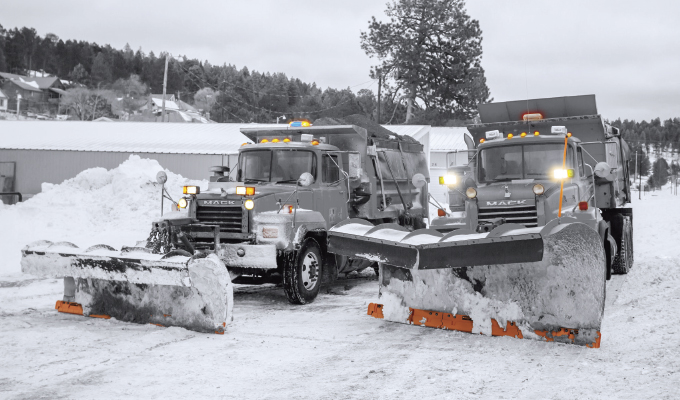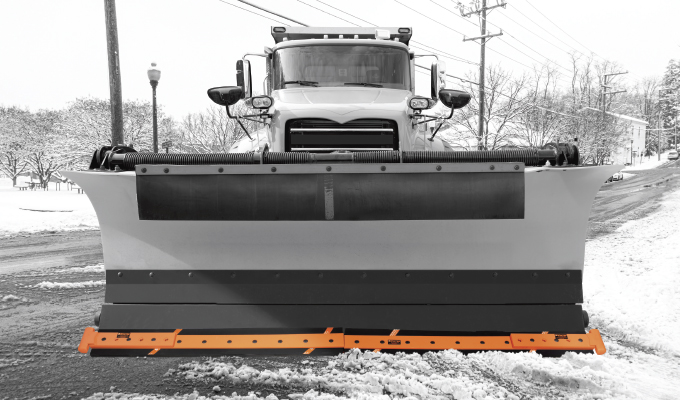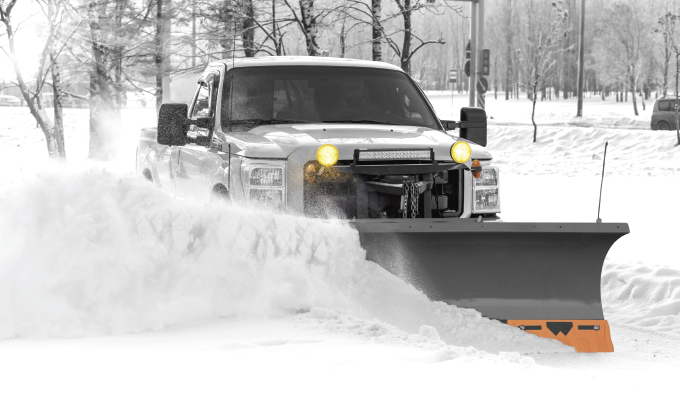Selecting a type of snowplow blade is a big decision to make—especially when there’s a couple of different kinds of blades to choose from. Whether removing snow and ice from driveways or clearing miles of highway lanes, it’s the snowplow blade that really gets the job done and affects performance. The right blades can clear away every snowflake while protecting the road surface and reducing the need for repairs when spring arrives.
Let’s explore several types of snowplow blades and the features, benefits, and challenges associated with each.
STEEL
Up against hard snowpack or ice? Steel is a cost-friendly blade option. Its accessibility and low up-front cost make it the first choice of many municipalities. About 60 to 75% of the snowplows currently in circulation use steel blades.
Steel performs well cutting through packed snow and ice on the road surface therefore decreasing the need for salt or chemical usage to clear roads. Steel blades provide the best scrape due to their tendency to cut aggressively. However, if a steel blade is installed without guards or shoes for protection, expect to see premature wear and numerous blade changes throughout the season.
Another downside is that using a steel blade improperly can cause major damage to the road surface, which, come spring, will require repairs.
Choosing a low budget steel blade for winter snow removal can save money upfront, while care must be taken to avoid costly road repairs in the spring. However, all blades will develop wear and tear differently throughout time.

RUBBER
Rubber snowplow blades have numerous advantages. Their flexibility makes them the perfect candidate for a blade that safely removes snow from decorative pavement. Rubber blades can actually contour to the surface of the roadway, allowing for greater accuracy and a higher rate of snow removal in wetter conditions. Further, rubber cutting edges act as a “squeegee” to move slushy snow. Their non-aggressive edge can be used on brick or decorative pavement without damaging expensive surfaces.
Rubber cutting edges are also great for clearing sensitive surfaces as they flex to accommodate the variations in the surface. Therefore, rubber blades are most effective in slushy, light, or fluffy snow. Oftentimes, rubber blades will not scrape away hard-packed snow and ice and will leave a layer behind, so it’s crucial that a rubber cutting edge is working alongside a comprehensive deicing strategy.
Within the selection of rubber blades available, there exists a hierarchy when it comes to the hardness of the blade. The standardized way of measuring the hardness of materials like rubber or plastic is called a durometer. It’s important to ensure that your rubber blades have a durometer level of at least 60 and a PSI (pounds per square inch) of at least 2,000. Car tires typically have a durometer of 70. If rubber blades don’t meet those requirements, premature wear, breakage, and roll-under is inevitable.
CARBIDE
Carbide blades have the cutting power of steel with a vastly increased life expectancy compared to other blades. Carbide insert blades are fantastic for medium-high speed plowing on road surfaces with few obstructions. These conditions are ideal because medium-high speed reduces impact on the blade, preventing the brittle carbide insert from cracking and washing out.
The longest lasting blade that an operator can use on the job is carbide, and used properly, it will end up saving more money in the long run. On average, a blade made with carbide can often last more than three seasons, while a steel blade may typically last a few snow events to perhaps a year.
Testing has shown that even one carbide blade has the durability of about 20 to 30 steel blades. Carbide blades can endure much heavier use than conventional snowplow blades and generally last much longer if the snowplow is maintained properly.
Carbide blades are designed to have a longer life including wear resistance to handle tough and icy winter conditions. Fleets that constantly replace steel snowplow blades throughout the winter season, might want to consider purchasing carbide.

THE RIGHT QUESTIONS
When choosing snowplow blades, it is important to consider what each blade is capable of, what kinds of road surfaces they will be used on (surface condition, potholes, manhole covers, bridge expansion joints, asphalt, concrete, etc.), and whether plowing high speed/long distance (highway) or low speed (municipal/rural). Ask the right questions and find out what product would best suit the fleet’s needs. Investing in a high-quality plow blade ensures you don’t have to worry about damaging the roads and that it will have a long life span.
Learning more about each blade will help fleets match the best cutting-edge for the situation that will eliminate the need for in-season blade changes, while also reducing damage to the roadways. Eliminating in-season blade changes also reduces the risk of worker injury, unnecessary downtime, and increasing productivity. Because freshly plowed roads promote safety and reduce accidents caused by slippery conditions.
FOR MORE INFORMATION
Curtis Winrod is the territory manager for Winter Equipment. With over six years of sales experience for Winter, Winrod provides day-to-day leadership to its customers. Winter Equipment has over 30 years of experience in providing solutions to the industry. Find out more, visit www.winterequipment.com.




